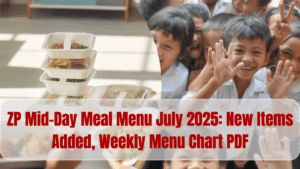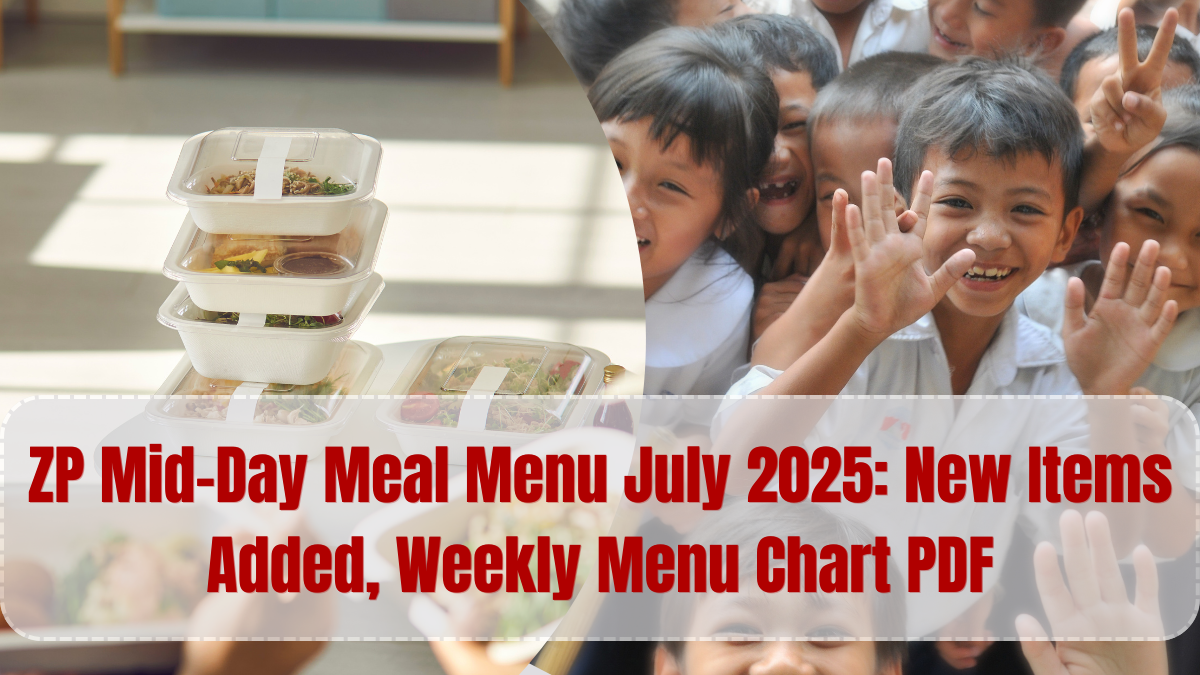The School Mid-Day Meal Menu July 2025 has been officially updated by the Zilla Parishad (ZP) authorities across several Indian states. As part of the National Programme of Mid-Day Meal in Schools, these changes ensure improved nutrition and taste for government primary and upper primary school students. The July 2025 menu not only includes a more diversified weekly chart but also introduces new seasonal vegetables, millets, and protein-rich additions to enhance student health.
ZP officials have coordinated with nutritionists and district education offices to finalize the latest meal chart. This update is aligned with the POSHAN Abhiyaan and NEP 2020 goals to provide balanced nutrition to children, improving both attendance and learning outcomes.

What’s New in the July 2025 Mid-Day Meal Menu?
The School Mid-Day Meal Menu July 2025 brings several exciting updates aimed at improving both nutrition and taste. Here’s what has changed:
-
Inclusion of millets like ragi and bajra twice a week
-
Seasonal fruits now included once a week (banana, guava, apple based on local availability)
-
Green leafy vegetables mandatory three times a week
-
Boiled eggs or chana included for added protein
-
Use of fortified oil and iodized salt for cooking
-
Hygiene checks implemented in every ZP school kitchen
These additions were based on feedback from teachers, local health officers, and student committees.
Weekly Mid-Day Meal Menu for July 2025 (Sample)
Here is a sample ZP menu structure followed in most states for July:
| Day | Primary Menu | Add-Ons / Notes |
|---|---|---|
| Monday | Khichdi with vegetables | Seasonal fruit (banana/guava) |
| Tuesday | Rice, Dal & Spinach Sabzi | Boiled chana or roasted peanuts |
| Wednesday | Ragi roti with potato curry | Jaggery water (gud pani) |
| Thursday | Vegetable pulao with curd | Iodized salt check, handwash session |
| Friday | Bajra khichdi with mixed vegetables | Lemon juice for iron absorption |
| Saturday | Rice & Egg curry / Chana masala | Health check and activity day |
Note: Regional variations exist depending on state climate, crop availability, and food culture.
Nutritional Goals and Student Benefits
The School Mid-Day Meal Menu July 2025 has been structured to meet the caloric and protein needs of students as per government health standards.
| Class Group | Calories Per Meal | Protein (grams) |
|---|---|---|
| Primary (Class 1–5) | 450–500 kcal | 12–15g |
| Upper Primary (6–8) | 700–800 kcal | 20g+ |
Additional goals include:
-
Preventing malnutrition and anemia
-
Boosting school attendance and student focus
-
Creating awareness about healthy eating habits at home
State-Wise Implementation Progress
Most Indian states have adopted the updated School Mid-Day Meal Menu July 2025, with local modifications:
-
Maharashtra, Tamil Nadu, Karnataka: Introduced millet-based recipes
-
Uttar Pradesh, Bihar: Focused on seasonal fruits and jaggery
-
Rajasthan, Gujarat: Included chana and iron-rich greens more frequently
-
Odisha, West Bengal: Launched special food tasting committees with parents
ZP officials also run surprise inspections to ensure food quality, hygiene, and feedback from students.
FAQs
What is new in the School Mid-Day Meal Menu July 2025?
The July 2025 menu includes millets, seasonal fruits, green vegetables, and added protein like eggs or chana to boost nutrition.
How often are menu updates issued by Zilla Parishad?
Menu updates usually happen quarterly or based on nutrition committee recommendations. July marks a new cycle of menu refresh.
Are eggs compulsory in all states?
No. Where eggs are not culturally acceptable, boiled chana, paneer, or soya chunks are given as alternatives.
How are allergies or special dietary needs handled?
Schools are advised to maintain student health cards. For allergies, alternate meals are arranged by the cook cum helper.
Are parents involved in this process?
Yes. School Management Committees (SMCs) and parents take part in feedback surveys and food tasting days.
Can private schools access this menu?
This menu is for government ZP schools only. However, private schools may adopt it voluntarily under state guidelines.
Click here to know more.
